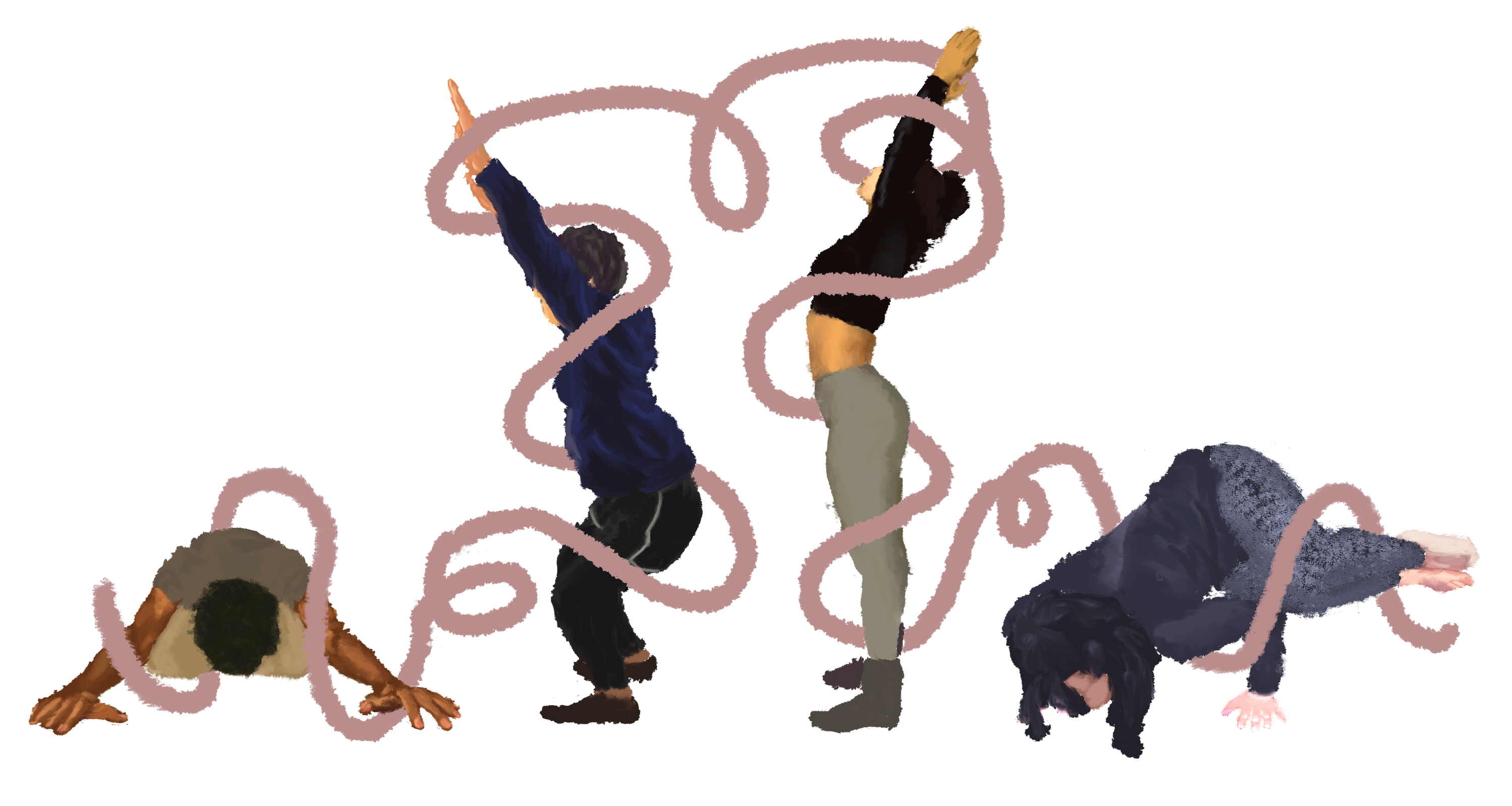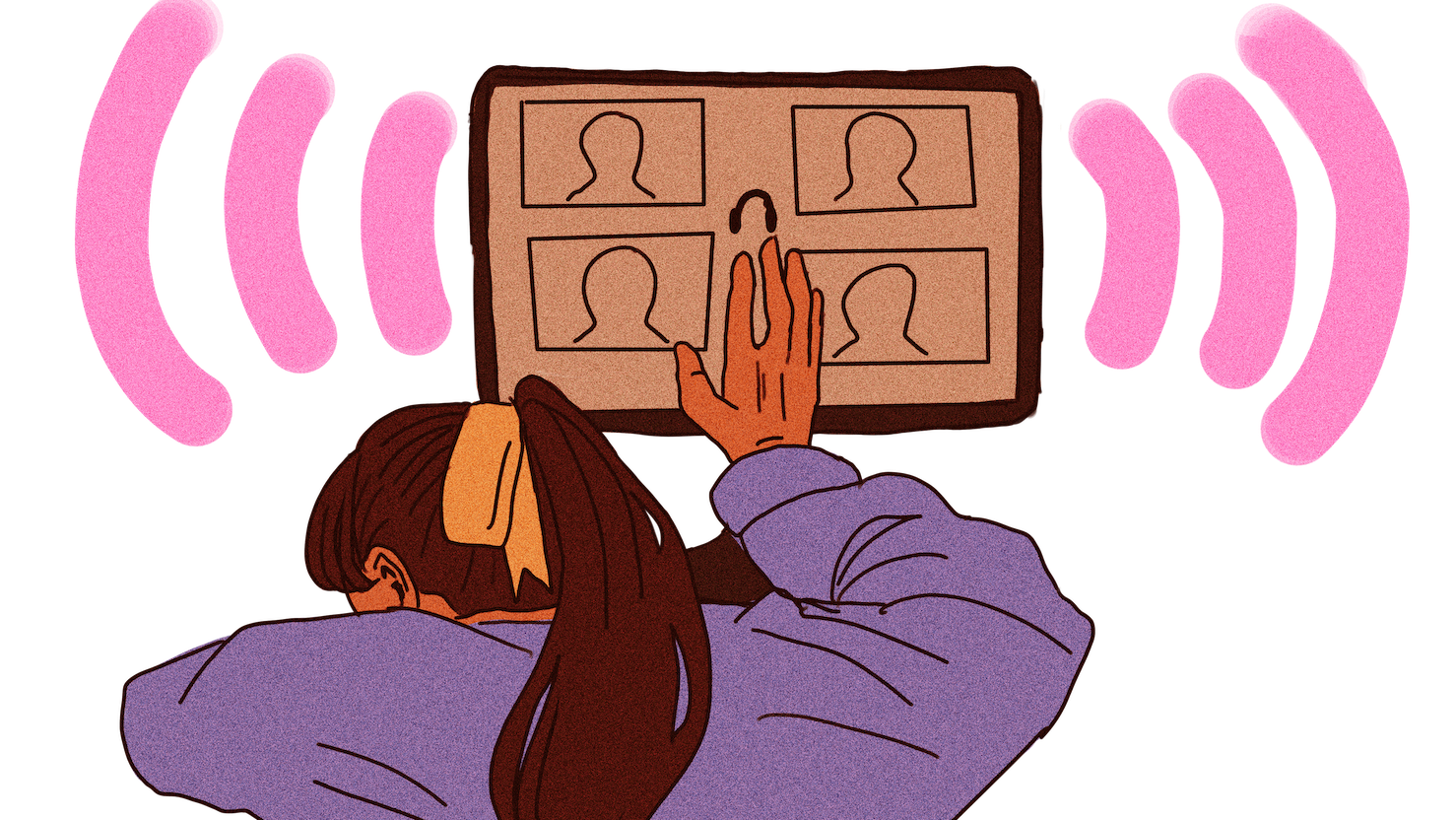Reflections in Yoga

Illustration by: Karina Arenas
Reflect back, it’s March 2020 and your world is now all on a screen. You’re on Zoom making sure you’re muted and you’re at a good angle (or your camera is turned off), while being told to “just concentrate”. Then, anger consumes you because of the perpetual injustice to Black people and lack of accountability by and to the nation state which infuriates you even more. Then, your professors or colleagues make it harder to adjust by ignoring these topics. Grappling with this new reality is grueling because of the unrealistic expectations to adjust innately and with little to no resources. You may have a space where issues are discussed head on to hold the U.S. accountable and raise awareness about injustices, but these topics begin taking a toll on your psyche and body. For me, that space was an Education course I took during the spring quarter of 2020.
My TA Destiny (Des) McLennan (Instagram) offered space to not only discuss class material, but also reflect on everything happening in the world and to us. Des is a Black woman, a phenomenal person, a brilliant and inspiring scholar and educator. She is a powerful yoga instructor who introduced me to the seamless connection between yoga and education. Weekly, she never failed to instill yoga in some form, whether it be a breathing exercise, small meditation, or end of the quarter yoga session. Des emphasizes, “Yoga is a practice. There is no goal, there is no prize at the end. The reward is the mental, spiritual, and physical benefits that YOU experience. It’s a consistent practice.” She always reassured us that we should make the practice suited to our own bodies. My first experience with yoga was comforting as it is powerful and stays true to the person. It doesn’t ask for over-exertion, it meets everyone’s mental and physical capabilities and never asks for more. This genuine consideration to help people is what makes it powerful. Harsh experiences can manifest in our body. Yoga centers around taking a moment to listen to your body. Listening helps us indicate what our body is experiencing and how these practices are helping these manifestations dissipate. When I first tried yoga on my own, I felt the manifestations of pain from events but later felt the alleviation of some of those feelings.
Yoga helped me take a breath and served as a reminder to myself that I am worthy of time and care. After slowly incorporating yoga into my life, I realized yoga is transformational, and I would like for it to help persons of color. I saw how yoga can serve as a form of healing for communities of color who at moments may not want to speak about what bothers them and also might not have access to mental health resources. When asked if she would recommend the practice to other persons of color, Des shared benefits and addressed a concern some people have when beginning this practice stating, “Yes. It is so beneficial spiritually and mentally. With what communities of color experience on the daily, yoga would definitely help in unpacking and releasing anything negative. I find that many people of color don’t practice yoga because they see it as sacrilegious.” Practicing yoga and retaining one’s religious beliefs is doable, Des clarifies they are not mutually exclusive and “yoga is a philosophy”.
To hear more about personal experiences regarding yoga as a practice for people of color, more specifically for Black women, I asked Karina Halliman, a senior at the University of California, San Diego, about her relationship with yoga. In January of 2020, Halliman was diagnosed with leukemia. When asked about her diagnosis she stated, “Diagnosis and treatment took a toll on me so I began therapy. I was recommended to find ways to move my body. Yoga was a low impact way I could move my body and feel grounded. After finding a great yoga instructor I was hooked. Through practice, I have found it has helped me more than just feel better physically.”
Karina also touched on the role yoga has in her life and the larger implications it brings. When asked “Is there a certain culture to yoga that is actively dismantled when people of color take this practice?” she said, “Absolutely, I want the stigma of yoga being only for skinny white women to stop. Everyone can do and benefit from yoga. You don’t need expensive yoga pants and equipment to do yoga. All it takes is making the time for yourself to do it. White people have capitalized on Eastern practices that I myself am having to unlearn. When I first became aware of yoga, I was taught it was a low impact workout… unaware that it is a practice with history and culture.”
Yoga is socially known as an “elitist white activity” and is popular in mainstream media amongst affluent, suburban, white women. However, yoga was created by people of color centuries ago and like many things, was appropriated. Anuradha Kowtha’s piece, “Decolonizing Yoga for People of Color and the Trope of the White Yoga Teacher”, speaks about the colonial realities and original traditions of yoga and shares how people of color can really benefit from this practice. Kowtha explains how people of color exponentially reclaimed yoga after it was once prohibited. Although starting yoga may be intimidating for beginners, Halliman shares: “Find a yoga teacher that doesn’t put unrealistic expectations on you. Some yoga instructors’ videos I have watched do very elaborate movements and make it look easy when it is not! That can make it feel inaccessible. Jessamyn Stanley (Instagram) is who I recommend for everyone. They give alterations for movements and let you know that some moves you won’t get on the first try or even the second, that’s why it’s a practice. Jessamyn gives detailed steps on how to do the movements that I haven’t seen many instructors do. The podcast ‘Yoga is Dead’ helped educate me about yoga and a great resource for finding culturally competent yoga instructors.”
Before the pandemic, depression and anxiety were leading in diagnoses for mental health conditions in the United States. According to the National Institute of Mental Health, 1 in 5 adults reported symptoms that fit the criteria for being diagnosed with anxiety. Now, a growing pandemic plagued with constant uncertainty and isolation forced us to take closer looks in the mirror to reevaluate relationships with ourselves and self-care. The World Health Organization defines self-care as “what people do for themselves to establish and maintain health, and to prevent and deal with illness.” Prioritizing self-care is necessary. While carving a time that feels right helps, it is difficult as the grip of capitalism forces us to put our needs second while subjecting our bodies to the labor market for immediate survival.
To understand if yoga is feasible during the pandemic I asked Halliman about personal feasibility, to which she responded, “I find yoga helps me step away from the overstimulation of screen time and provides me the ability to move my body when I am at my computer and the couch most days. It has also given me a space to make time for a good friend of mine. We schedule time every week to do yoga together over Zoom. It helps me stay accountable to keep going.”
These tough moments made undeniable demonstrations of how capitalism runs rampant without caution to our bodies, so I wanted to highlight Halliman’s favorite yoga pose “Shavasana.” She elaborated how “you are laying on your back with legs and arms spread out, taking up space. A very vulnerable pose as you’re that open. I am able to absorb the movements I had done in my practice and be completely still for a moment in time and be present in the moment. Taking up space reminds me that I do not need to make myself small… and it also makes my back feel really good.”
A yoga style Des recommends is “Yin” which she describes as “a practice that is very different from the more traditional styles… It’s grounded, meaning you stay on the floor most of the time. It has three defining characteristics. 1. Cold relaxed muscles. In Yin, you want to relax your muscles as much as possible because we’re working past the muscles into the fascia (connective tissue). Putting stress on our fascia allows joint lubrication, which increase joint mobility, flexibility, and range of motion. 2. Long holds. In Yin we hold poses for long periods of time because that is what stresses the fascia. And 3. A commitment to stillness. So, once you find how the shape works for you in your own body, you want to commit to stillness.”
Yoga is a practice that meets you wherever you’re at and is a practice that is flexible with what you want and are able to do. Capitalism, as Karl Marx explains, removes the autonomy we have over our bodies and places it in the control of corporations who manage us for the sake of accumulating wealth and power. Yoga is a form of pushing back against capitalist norms to preserve the agency we have over our bodies. Reclaiming the bodies we did not know we were ever out of touch with is instrumental, and our reflections are essential to how we move through the world and the boundaries we set. As persons of color, it is important for us to assess our bodies frequently as we are socialized to just keep going, hecharle ganas, and push forward. This is a reminder that you are worthy of rest and care.








Leave a Reply
Want to join the discussion?Feel free to contribute!